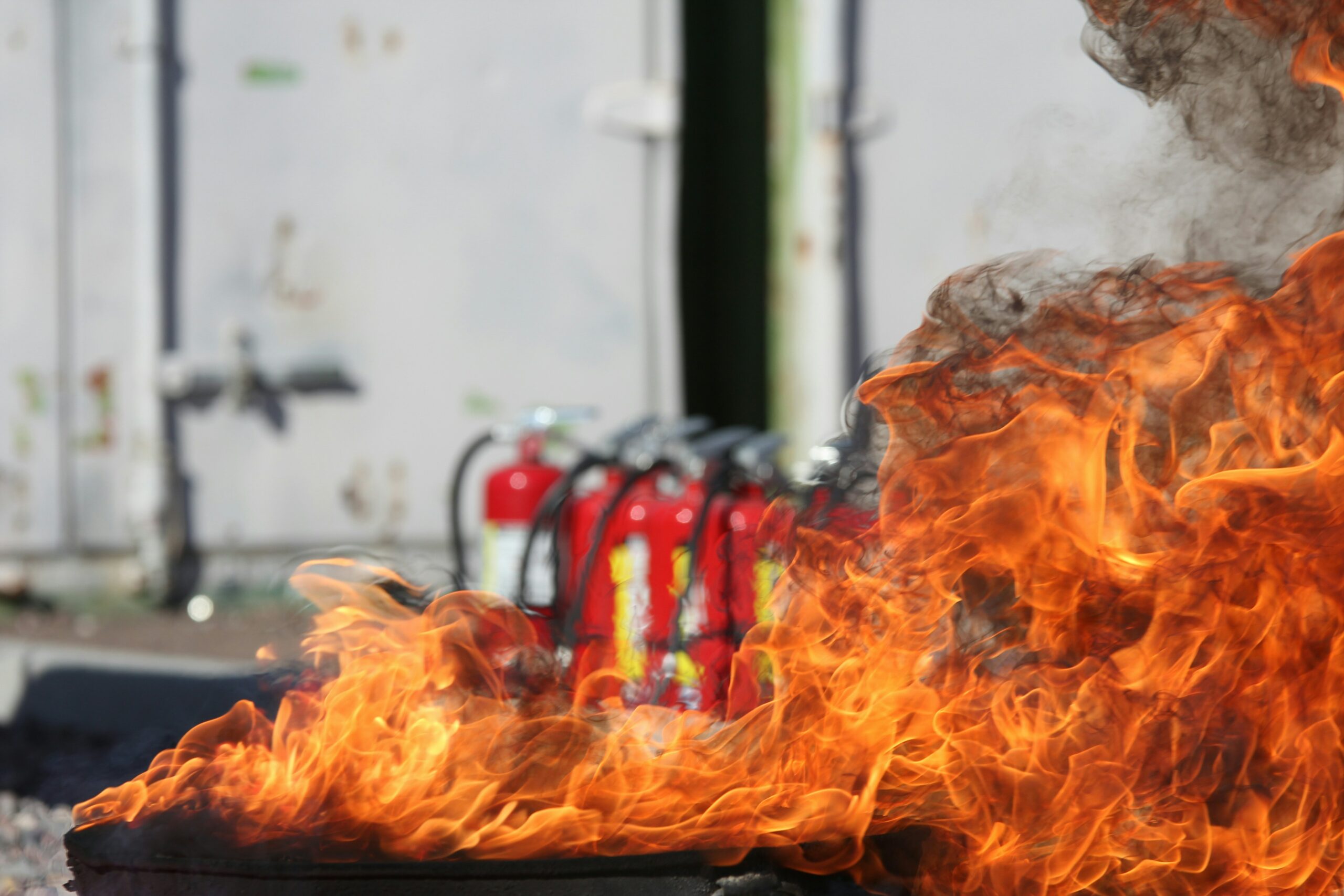How Often Should Fire Extinguishers Be Inspected?

Fire safety is a crucial component of any workplace health and safety legislation. Maintaining fire safety equipment is therefore of the utmost importance for keeping employees and visitors safe. This guide will focus on the role of fire extinguishers in the workplace, and answer the question, ‘how often should fire extinguishers be inspected?’. You’ll also find information about what to include on a fire extinguisher inspection checklist, when to book a fire extinguisher service, and how to dispose of fire extinguishers safely.
How Often Should Fire Extinguishers Be Inspected?
The designated fire marshal or person responsible for fire safety within a workplace should conduct a basic fire extinguisher inspection once a month. This involves simple visual checks, such as looking at the pressure gauge, headcap pin and seal, and making sure that there’s no damage, loss of pressure or tampering. You should also ensure that the fire extinguisher is secured in position and easily accessible, with no obstructions, should you need to use it. This simple fire extinguisher inspection should take only a few minutes to complete each month and could be done at the same time as checking any fire escape routes.
How Often Should Fire Extinguishers Be Serviced?
For a more thorough examination, all fire extinguishers should be serviced annually. This involves a much more thorough check than a fire extinguisher inspection, and is usually completed by a third party accredited fire extinguisher technician. There are two types of fire extinguisher service:
1. A basic annual service
In accordance with the BS 5036-3 regulation as set out by The British Approvals for Fire Equipment (BAFE), every commissioned fire extinguisher must undergo a service once a year. You may need to check the type of fire extinguisher you have to ensure that the correct service is administered. Generally, a basic fire inspection service will involve:
- Visual checking for any dents, cracks or corrosion
- Verifying that the safety pin and tamper seal are intact
- Confirming that the pressure gauge is in the correct range
- Monitoring the expiration date
- Hydrostatic testing to determine if the extinguisher’s cylinder can withstand pressure
- Refilling or recharging if the extinguisher has been used
- Cleaning the exterior and any parts
- Replacing any expired or faulty parts
- Keeping a service record
2. An extended annual service
An extended service needs to be conducted for water, foam, powder, and wet chemical extinguishers once every five years. The extended service is a thorough assessment of the fire extinguisher and also involves discharging the extinguisher to ascertain the pattern, distance and duration of the discharged fire suppressant to ensure it is within specification. The extinguisher will be disassembled so it can be checked in meticulous detail and, if necessary, refilled and the pressure adjusted.
For CO2 extinguishers, an extended service is required every 10 years and is called an overhaul. This is because they have a much higher pressure than other fire extinguishers and, as such, are subject to slightly different regulations.
Even with regular services, you should still aim to complete a fire extinguisher inspection once a month to maximise employee safety.
Types Of Fire Extinguisher

The type of fire extinguisher inspection and service required can depend on the type of fire extinguisher. These are the different fire extinguishers you will usually come across:
1. Water-Based Fire Extinguishers
These are commonly used for Class A fires, which involve ordinary combustibles like wood, paper and textiles. They operate by cooling the burning material and are suitable for use in homes and businesses, and are often found in offices. They should not be used on electrical fires, or hazardous and flammable liquids.
2. Powder Extinguishers
Powder extinguishers work by forming a barrier between the fuel and the oxygen or by interrupting the chemical reaction of the fire. They can tackle Class A, B, and C fires and so are ideal for environments with varied fire risks, for example, construction sites.
3. Powder-Primary Sealed Extinguishers
Powder-primary sealed extinguishers are particularly effective in industrial settings where there might be longer periods between services. They are similar to standard powder extinguishers, but feature a sealed system for enhanced longevity and performance.
4. Clean Agent Extinguishers
Also known as gaseous fire extinguishers, clean agent extinguishers are effective on Class B and C fires. They’re ideal for protecting sensitive electronic equipment, as they leave no residue, and are used in the aviation and healthcare industries.
5. CO2 Extinguishers
CO2 extinguishers work by displacing oxygen and cooling the fire. They’re best suited for Class B and C fires and do not leave any residue. CO2 extinguishers are the only extinguishers that can be used on flammable liquid fires.
Fire Extinguisher Inspection Checklist

As a guide, these are the typical items to include in your monthly fire extinguisher inspection checklist:
- Ensure the gauge indicates proper pressure and that it is in the green zone.
- Check that the tamper seal is intact and not broken.
- Verify that the service label has the date of the last inspection and any servicing information.
- Look for any dents, corrosion, or leakage on the extinguisher body.
- Confirm the extinguisher is the appropriate type for the potential fire hazards in the area.
- Perform a thorough visual check for any visible blockages, especially in the nozzle.
- Ensure the extinguisher is not obstructed and is in an easily accessible location.
- Look at the remaining time left before the extinguisher needs replacing. Fire extinguishers usually last between 10 and 12 years if not used.
- Record your findings in a logbook.
How To Dispose Of Fire Extinguishers
As businesses have a legal duty to dispose of waste correctly, you must ensure that you comply with the law and will need to remove fire extinguishers responsibly. This is important for safety, compliance, and to reduce the environmental impact. If you have a small number of fire extinguishers, you may be able to take them to a local recycling centre or scrap metal centre. As fire extinguishers contain hazardous chemicals, you will need to check that the place you take them to is equipped to dispose of hazardous waste. For a larger number of fire extinguishers, consider using a waste management company that can ensure they are taken from your premises and disposed of or recycled.
You will need to dispose of a fire extinguisher when:
- It has reached its expiration date. Fire extinguishers usually last between 10 and 12 years and this should be clearly labelled
- It has been damaged, for example, cracks, a broken handle or the pressure gauge is in the red or yellow
- It has been used and cannot be recharged
- The inspection sticker and information is missing so you do not know how old it is or when it was last serviced
Fire Safety From Rhino Safety
Rhino Safety can support your business to manage and maintain all aspects of your fire safety policies. As trusted health and safety experts, we have decades of experience delivering bespoke solutions to companies of all sizes. We can conduct a thorough health and safety audit to determine how your fire safety can be improved, and perform fire risk assessments that ensure your workplace is a safe and compliant one. We also offer fire marshal training that gives your employees the knowledge they need to administer ongoing fire safety practices. Talk to us today about our tailored health and safety solutions.
